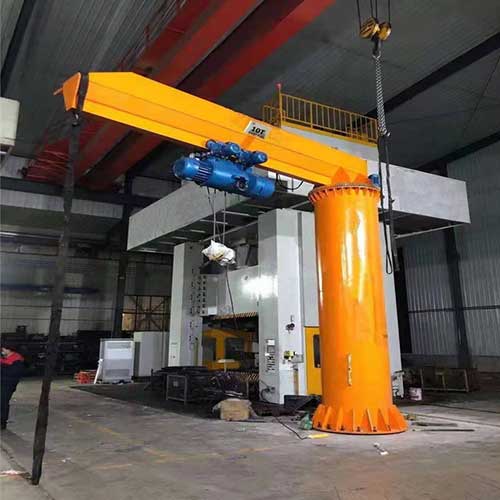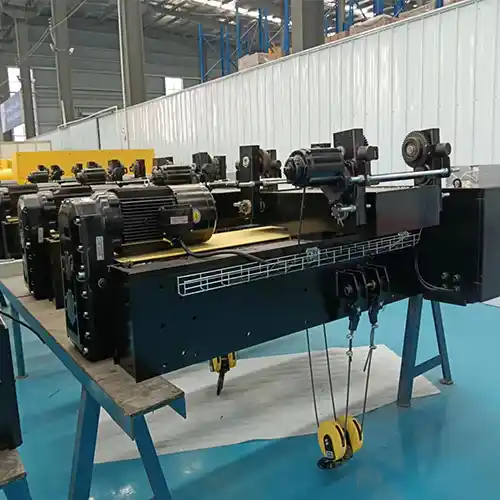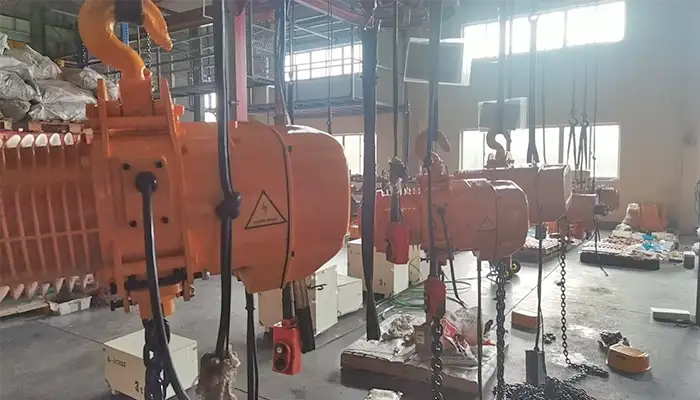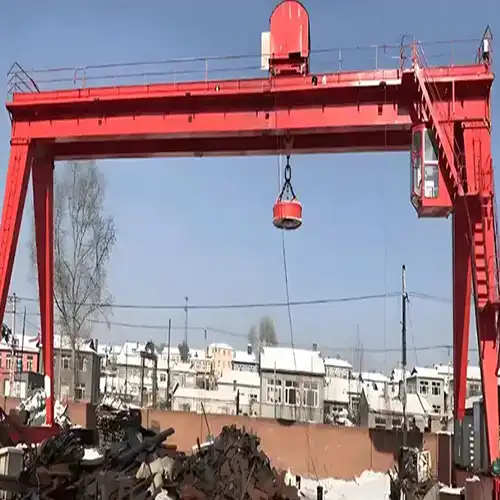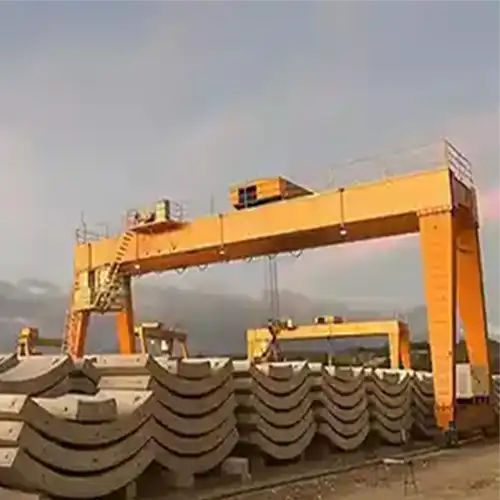Floor Mounted Jib Cranes & Floor Jib Crane 1 Ton -16 Ton For Sale
Floor mounted jib cranes for sale. Overview of types of floor jib cranes 1 ton to 16 ton and typical industrial uses.Get your floor mounted crane design!
| Jib crane type | Floor mounted jib crane |
| Crane capacity | 500kg, 3 ton, 5 ton, 10 ton, 16 ton |
| Lifting height | As your request |
| Crane Span | As customer requirement |
Category: Floor Mounted Crane
Your Trusted Floor Mounted Crane Manufacturer & Supplier
Floor Mounted Jib Cranes & Floor Jib Crane 5 Ton, 10 Ton 16 Ton
Floor mounted jib cranes for sale. Overview of types of floor jib cranes 1 ton to 16 ton and typical industrial uses.Get your floor mounted crane design!
A floor mounted jib crane is a versatile lifting solution designed to simplify the movement of heavy loads within confined spaces. Anchored securely to the floor, these cranes provide pivotal lifting and positioning capabilities, all while occupying a limited footprint. The key components include a vertical column or mast, a horizontal jib arm, and a hoist or trolley mechanism that facilitates smooth load movement.
Why Floor Mounted Jib Cranes are Essential for Industrial Material Handling
The value of floor mounted jib cranes lies in their ability to streamline material handling tasks with utmost precision. These cranes excel in scenarios where a full overhead crane system might be excessive or impractical. Their adaptability in diverse environments makes them indispensable tools for manufacturers, warehouses, construction sites, and more.
The ergonomic design of floor mounted jib cranes empowers operators to handle heavy loads with minimal effort. This not only enhances worker safety but also optimizes operational efficiency. By reducing manual labor and expediting material movement, these cranes contribute to smoother workflows and increased productivity.
Overview of floor mounted jib cranes
A floor-mounted jib crane is a type of industrial lifting equipment designed to assist with material handling tasks within a limited workspace. It consists of a vertical mast or support column that is anchored to the floor, and a horizontal jib arm that extends from the mast. This jib arm can rotate around the mast, providing a circular area of coverage where loads can be lifted, moved, and positioned.
Key features of floor-mounted jib cranes include:
- Mast: The vertical mast serves as the main support structure for the crane. It is securely anchored to the floor and provides stability for the crane's operation.
- Jib Arm: The jib arm is the horizontal beam extending from the mast. It can rotate around the mast, allowing for precise positioning of loads. The jib arm's length determines the reach of the crane.
- Rotation Mechanism: A mechanism is employed to facilitate the rotation of the jib arm around the mast. This rotation enables the crane operator to move loads horizontally within the crane's coverage area.
- Hoist or Lifting Mechanism: The lifting mechanism, often in the form of a hoist or a chain block, is attached to the jib arm. It allows the crane to lift and lower heavy loads vertically. The lifting capacity of the crane is determined by the strength of the hoist and the crane's design.
- Foundation and Support: The crane is securely mounted on a concrete foundation using anchor bolts. This foundation provides stability and load distribution for the crane's operation.
Floor-mounted jib cranes are versatile tools commonly used in various industries such as manufacturing, warehouses, workshops, and assembly lines. They are particularly useful in situations where overhead space is limited, but lifting and moving heavy objects is necessary. These cranes come in different configurations, such as freestanding, wall-mounted, and mast-type, to suit different spatial constraints and lifting requirements.
Overall, floor-mounted jib cranes offer efficient and controlled material handling solutions, increasing productivity and reducing the physical strain on workers during lifting and positioning tasks.
What are The Main Types of Floor Mounted Jib Cranes ?
Based on Lifting Capacity:
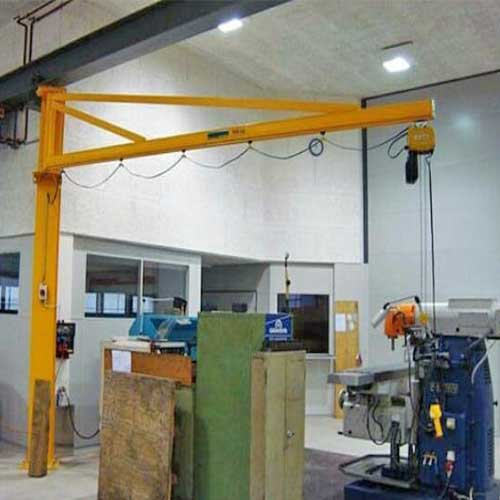
Light-Duty Floor Mounted Jib Crane
- Designed for relatively lighter loads.
- Commonly used in workshops, assembly lines, and maintenance tasks.
- Lifting capacity typically ranges from a few hundred pounds to a few tons.

Medium-Duty Floor Mounted Jib Crane 10 Ton
- Offers higher lifting capacity compared to light-duty cranes.
- Suitable for moderately heavy loads in manufacturing and industrial settings.
- Lifting capacity usually ranges from a few tons to around 10 tons.
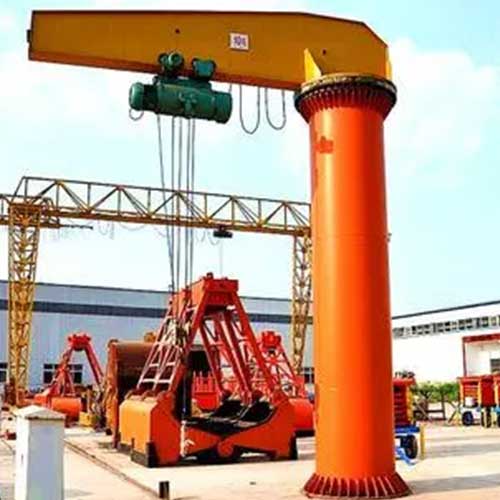
Heavy-Duty Floor Mounted Jib Crane
- Engineered for lifting heavy loads.
- Used in heavy industrial applications, foundries, and shipyards.
- Lifting capacity can exceed 10 tons, depending on the design and application.
Based on Cantilever Design:

Standard Cantilever Floor Mounted Jib Crane:
- Design: This type of jib crane features a jib arm that extends directly from the column in a fixed horizontal orientation. The jib arm is rigidly connected to the column.
- Functionality: The crane can rotate around the column, providing a circular working area within its radius. The load can be lifted, moved horizontally, and positioned at various points within the coverage area.
- Applications: Standard cantilever jib cranes are commonly used in scenarios where loads need to be moved back and forth along a linear path. They are suitable for tasks like transferring materials from one location to another, feeding machines, and facilitating general material handling operations.
- Advantages: These cranes are simple in design and provide reliable lifting and positioning capabilities. They are effective for applications that require regular, repetitive movements within a defined radius.
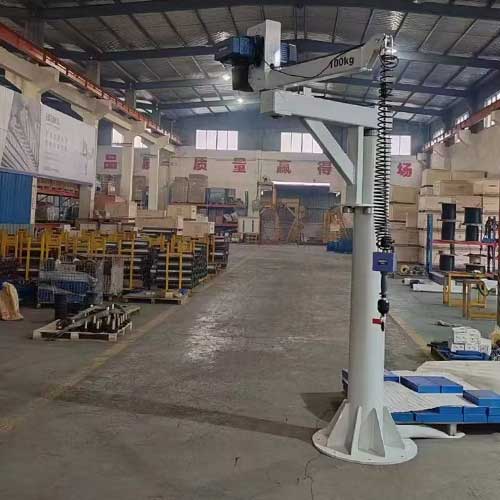
Articulating Cantilever Floor Mounted Jib Crane:
- Design: An articulating cantilever jib crane, also known as a knuckle jib crane, has a jib arm with multiple pivot points, allowing for greater flexibility in movement.
- Functionality: The multiple pivot points enable the crane to articulate and extend its jib arm in various directions. This design allows the crane to reach around obstacles, access confined spaces, and perform intricate material handling tasks.
- Applications: Articulating cantilever jib cranes are well-suited for tasks that require precise positioning in tight or complex spaces. They are commonly used in assembly lines, machining operations, and areas with obstacles that traditional cranes might struggle to navigate.
- Advantages: The flexibility provided by the articulating design makes these cranes versatile and adaptable to a range of applications. They excel in scenarios where traditional straight-arm cranes would be limited by space constraints or obstacles.
In summary, the choice between a standard cantilever and an articulating cantilever floor mounted jib crane depends on the specific material handling needs of the application. If straightforward horizontal movements are sufficient, a standard cantilever crane might be suitable. However, if tasks require reaching around obstacles or into confined spaces, an articulating cantilever crane offers the necessary flexibility.
Based on foundations of floor mounted jib cranes
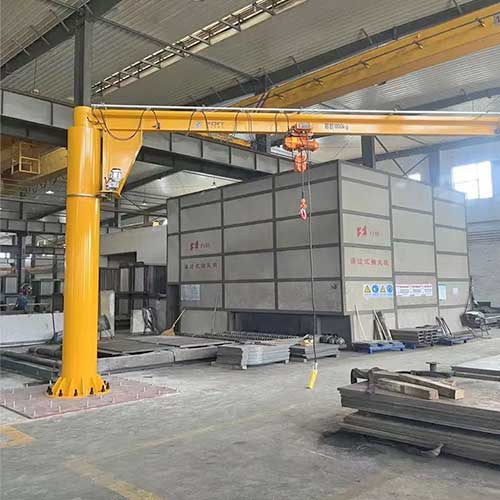
Foundation Jib Cranes:
Foundation jib cranes require a dedicated concrete foundation to be installed. The foundation serves as the base on which the crane's support structure, such as the column or mast, is securely anchored. This foundation provides stability and load distribution for the crane's operation. The installation of a foundation can involve digging, pouring concrete, and anchoring the crane's support structure using anchor bolts.
Advantages
- Provides a stable and secure base for the crane.
- Suitable for heavy-duty applications and larger cranes.
- Ensures proper load distribution and minimizes stress on the floor.
- Can accommodate cranes with higher load capacities.
Considerations
- Requires more planning and construction time due to foundation installation.
- May involve additional costs for concrete work and labor.
- Suitable for permanent installations where the crane's position won't need frequent changes.
Foundationless jib cranes
Foundationless jib crane that is designed for light loads handling and can be directly anchored to the cement floor using bolts. This type of crane is indeed a practical solution for smaller-scale lifting tasks. It's typically used in scenarios where heavy-duty lifting is not required, and the crane's installation needs to be straightforward and without the need for a separate foundation.
Advantages:
Foundationless jib cranes for light loads have some distinct advantages:
- Simplicity: These cranes are relatively easy to install due to the absence of a separate foundation. Bolting them directly to the cement floor reduces installation time and complexity.
- Cost-Effective: Foundationless jib cranes are often more budget-friendly than cranes that require a dedicated foundation. This makes them an attractive option for businesses with limited resources.
- Flexibility: Their lightweight and portable nature allows for easy relocation if needed. This flexibility can be beneficial in dynamic work environments.
- Quick Deployment: Since no concrete work is necessary, the crane can be put into operation shortly after installation, minimizing downtime.
- Light Loads: These cranes are designed for handling light loads, which is suitable for tasks involving smaller items that do not exceed the crane's weight capacity.
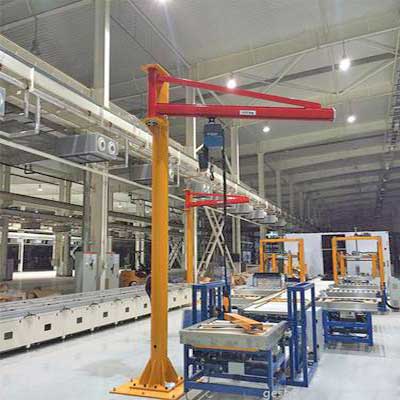
Considerations of foundationless jib cranes no more than 500kg :
- Load Limitation: Foundationless jib cranes are limited in terms of the weight they can handle. Exceeding the crane's load capacity can result in safety risks and reduced performance.
- Stability: While suitable for lighter loads, these cranes may not provide the same level of stability and load-bearing capacity as foundation jib cranes.
- Application: Due to their design, foundationless jib cranes are best suited for tasks with light loads and simple lifting requirements. They may not be appropriate for heavy-duty industrial applications.
In summary, foundationless jib cranes designed for light loads are a practical solution for situations where simplicity, budget considerations, and quick installation are important factors. However, their usage should be aligned with the specific lifting needs of your application to ensure safety and efficiency.
Special and Optional Features for Floor Mounted Jib Cranes
Floor-mounted jib cranes can be equipped with various special features to enhance their suitability for specific environments and applications. Some of these features include:
- Explosion-Proof Design - In environments with flammable gases, vapors, or dust, explosion-proof jib cranes are constructed to prevent ignition sources.- Special components and materials are used to ensure electrical safety and minimize the risk of sparks or explosions.
- Corrosion Resistance - In settings exposed to moisture, chemicals, or saltwater, cranes can be coated with corrosion-resistant finishes or materials.- Stainless steel or specialized coatings protect against rust and corrosion, extending the crane's lifespan.
- Cleanroom Compatibility - Cleanroom jib cranes are designed for use in environments with stringent cleanliness requirements, such as pharmaceutical or semiconductor manufacturing.- These cranes are constructed with smooth surfaces and minimal exposed hardware to prevent particle contamination.
- Food-Grade Applications - Cranes used in the food and beverage industry may have stainless steel construction to meet hygiene standards.- Smooth surfaces, sealed joints, and resistance to harsh cleaning chemicals are common features.
- Weatherproofing - Cranes installed outdoors or in open-air environments can be weatherproofed with seals, gaskets, and coatings.- This prevents water, dust, and debris from affecting crane performance and longevity.
- Remote Control - Some floor-mounted jib cranes can be equipped with remote control systems for convenient operation from a distance.- Remote controls enhance operator safety by allowing them to control the crane without being in close proximity.
- Load Monitoring and Safety Systems - Advanced jib cranes can be equipped with load monitoring systems to prevent overloading.- Safety features like limit switches, anti-collision systems, and load sensors ensure safe operation.
- Environmental Sealing - In dusty or harsh environments, cranes can be sealed to prevent debris from affecting internal components.- This enhances the crane's durability and reduces maintenance needs.
- Variable Speed Control - Some cranes offer variable speed control mechanisms, allowing operators to control the speed of movements more precisely.
- Vibration Damping - In environments with vibrations, cranes can be equipped with damping mechanisms to reduce vibration transmission and improve stability.
- High-Temperature Resistance - Cranes used in high-temperature environments like steel mills or foundries may have heat-resistant components.- Insulation and refractory materials prevent damage from extreme heat.
- Low-Headroom Design - In areas with limited vertical space, low-headroom jib cranes are designed to minimize the crane's overall height while maintaining optimal lifting capacity.
These special features are designed to address specific challenges and requirements posed by various industries and environments. When considering a floor-mounted jib crane for a particular application, it's important to assess which special features are necessary to ensure safe, efficient, and reliable operation.
Manufacturing Workstations
Floor-mounted jib cranes enhance material handling at individual manufacturing workstations, aiding workers in moving components efficiently.
Capacity: Up to 1 ton
Tailored Features: Compact design, rotation control, lightweight
Main Functions: Lifting and positioning components, aiding in assembly
Applications: Electronics assembly lines, small-scale workshops
Loading and Unloading at Docks
Floor jib cranes streamline loading and unloading operations at docks, facilitating the movement of goods from trucks and containers.
Capacity: Up to 16 tons
Tailored Features: 360-degree rotation, sturdy construction, durable finish
Main Functions: Transferring goods, loading and unloading shipments
Applications: Freight hubs, ports, shipping terminals
Assembly Line Assistance
Integrated into assembly lines, floor-mounted jib cranes assist in assembling products by positioning components accurately.
Capacity: Up to 16 tons
Tailored Features: 360-degree rotation, sturdy construction, durable finish
Main Functions: Transferring goods, loading and unloading shipments
Applications: Freight hubs, ports, shipping terminals
Machine Shop Support
Within machine shops, floor jib cranes are indispensable for transporting heavy machinery parts and tools for machining tasks.
Capacity: Up to 2 tons
Tailored Features: Strong load capacity, lateral movement, stable base
Main Functions: Transporting machinery parts, aiding in machining
Applications: Metalworking shops, industrial machining
Maintenance and Repair Workshops
Floor-mounted jib cranes are pivotal in maintenance workshops, lifting and positioning machinery and equipment for repair work.
Capacity: Up to 5 tons, 2 ton,
Tailored Features: Lifting power, rotation range, ease of control
Main Functions: Lifting machinery, assisting in repairs
Applications: Plant maintenance, automotive repair shops
Efficient Tool Handling
Across industries, floor jib cranes move tools between storage and workstations, optimizing tool management.
Capacity: Up to 1 ton
Tailored Features: Tool storage, quick swiveling, attachment points
Main Functions: Transporting tools, facilitating tool access
Applications: Manufacturing lines, maintenance workshops
Optimized Material Storage
Installed in storage areas, floor-mounted jib cranes efficiently manage materials and parts, ensuring easy retrieval.
Capacity: Up to 2 tons
Tailored Features: Load capacity, height adjustability, 360-degree coverage
Main Functions: Organizing materials, transferring to/from storage
Applications: Warehouses, distribution centers
Streamlined Paint Booth Operations
Automotive and manufacturing sectors benefit from floor jib cranes that move vehicle bodies or parts through paint booths.
Capacity: Up to 5 tons
Tailored Features: Paint-resistant finish, steady rotation, light load capacity
Main Functions: Moving workpieces in/out of paint booths, rotating for even paint
Applications: Automotive painting, industrial coating
Warehouse Material Management
Within warehouses, floor jib cranes facilitate material movement between shelves, conveyor belts, and packaging stations.
Capacity: Up to 3 tons
Tailored Features: Efficient movement, wide coverage, ergonomic design
Main Functions: Transporting materials, loading/unloading shelves
Applications: Warehousing, e-commerce fulfillment
Seamless Loading onto Production Equipment
Floor jib cranes ensure continuous material supply by placing raw materials onto production machinery.
Capacity: Up to 2 tons
Tailored Features: Precise positioning, stable base, quick setup
Main Functions: Placing raw materials onto machinery, continuous supply
Applications: Manufacturing, food processing
Foundry and Metalworking Support
In foundries, floor-mounted jib cranes handle molds, castings, and hefty metal components during production processes.
Capacity: Up to 5 tons
Tailored Features: Heat-resistant finish, heavy load capacity, 360-degree rotation
Main Functions: Handling molds, castings, metal components
Applications: Foundries, metal fabrication
Construction Site Efficiency
Construction sites rely on floor jib cranes to transport construction materials, tools, and equipment to different building levels.
Capacity: Up to 3 tons
Tailored Features: Construction-durable design, versatile positioning, 360-degree rotation
Main Functions: Moving construction materials, supporting tasks
Applications: Building construction, infrastructure projects
Maritime Industry Assistance
Shipyards benefit from floor jib cranes that lift and position large ship sections during construction and repairs.
Capacity: Up to 10 tons
Tailored Features: Corrosion-resistant finish, sturdy construction, heavy load capacity
Main Functions: Lifting and placing ship sections, transporting equipment
Applications: Shipbuilding, marine repair facilities
Retail and Warehousing Optimization
Retail warehouses maximize inventory management with floor jib cranes that move products effectively within storage spaces.
Capacity: Up to 2 tons
Tailored Features: Material storage support, light to medium load capacity, efficient access
Main Functions: Managing inventory, transporting products
Applications: Retail distribution, e-commerce fulfillment
Agricultural Operations Enhancement
Agriculture operations employ floor-mounted jib cranes to manage equipment, feed, and supplies within barns and storage areas.
Capacity: Up to 5 tons
Tailored Features: Light load capacity, quick movement, simple operation
Main Functions: Handling equipment, transporting supplies
Applications: Farms, livestock operations
Capacity of 1 Ton to 16 Ton Floor-Mounted Jib Cranes for Sale
Floor-mounted jib cranes come in a range of capacities from 1 ton to 16 tons, catering to various industrial needs. Each capacity range serves different operational requirements, from light-duty applications to heavy-duty tasks. Here's a detailed look at what you can expect from each capacity range:

125kg, 500kg / 0.5 Ton to 1 Ton
Applications:
- Small Workshops: Ideal for lifting small tools, components, and parts in a compact workshop or repair facility.
- Home Garages: Suitable for DIY projects and home workshops where space is limited and only light loads are handled.
- Inventory Management: Efficient for handling light materials and small parts in retail or small warehouse settings.
Features:
- Compact Size: Designed to fit in tight spaces, these cranes are usually smaller and more maneuverable, making them ideal for confined work areas.
- Precision Handling: Provides accurate control for lifting delicate or small items, reducing the risk of damage.
Considerations:
- Load Limits: Ensure that the crane's capacity is sufficient for your needs, as overloading can affect performance and safety.
- Installation: Typically requires minimal floor space and installation adjustments, making it easier and more cost-effective to set up.

1 Ton to 2 Tons
Applications:
- Small to Medium Workshops: Suitable for handling a wider range of light to moderate loads, including medium-sized tools and components.
- Small Manufacturing Units: Useful for moving small machinery and parts, improving efficiency in production lines.
- Maintenance Facilities: Ideal for tasks that require lifting and repositioning of moderate-sized equipment.
Features:
- Extended Reach: Offers more reach than 0.5 ton models, allowing for increased flexibility in handling various loads.
- Enhanced Durability: Constructed to handle slightly heavier loads with more robust materials compared to smaller cranes.
Considerations:
- Space and Layout: Requires adequate floor space to operate effectively and safely. Ensure that the layout accommodates the crane's reach and movement.
- Load Distribution: Ensure the crane can evenly distribute the load across its jib arm to maintain stability and prevent overloading.

2 Tons to 3 Tons
Applications:
- Medium Workshops and Factories: Effective for lifting and moving moderate to heavier loads such as machinery components and large tools.
- Warehouse Operations: Useful in handling larger inventory items and materials, enhancing the efficiency of warehousing operations.
- Assembly Lines: Ideal for moving components and tools along production lines, improving workflow and productivity.
Features:
- Greater Stability: Designed with stronger construction and materials to handle heavier loads, providing stability and reliability.
- Enhanced Reach and Flexibility: Provides more reach compared to lower capacity models, allowing for greater operational flexibility.
Considerations:
- Foundation Requirements: Requires a more robust floor foundation to support the higher loads and ensure stable operation.
- Installation Costs: May involve higher installation costs due to the need for a stronger base and potential modifications to the workspace.

4 Ton to 5 Tons
Applications:
- Small Workshops: Ideal for handling lightweight components and tools, making them suitable for small-scale manufacturing and maintenance tasks.
- Inventory Management: Used in warehouses for moving light items and materials, facilitating efficient stock handling and retrieval.
Features:
- Compact Design: These cranes are typically more compact and suited for confined spaces where space is a premium.
- Precision Handling: They offer high precision for delicate or small components, reducing the risk of damage during lifting.
Considerations:
- Load Distribution: Ensure that the crane can handle the distribution of lighter loads evenly across the jib arm.
- Environmental Factors: Suitable for indoor use in environments with minimal exposure to harsh conditions.
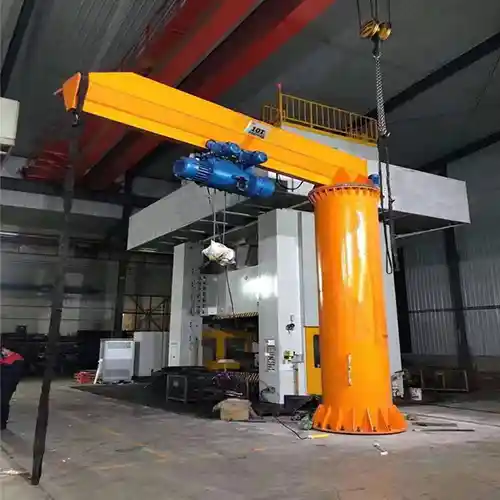
6 Tons to 10 Tons
Applications:
- Medium-Sized Manufacturing Facilities: Useful for lifting and moving moderate-sized machinery parts, tools, and materials within a workshop or assembly line.
- Distribution Centers: Effective for handling medium-sized inventory and equipment in warehouses and distribution centers.
Features:
- Extended Reach: These cranes often have an extended jib arm to handle a broader range of tasks and reach further distances.
- Robust Construction: Designed with stronger materials and construction to support heavier loads and more frequent use.
Considerations:
- Space Requirements: Requires adequate floor space for safe operation and maneuvering of heavier loads.
- Installation: May need a more robust foundation and installation setup compared to lighter cranes.
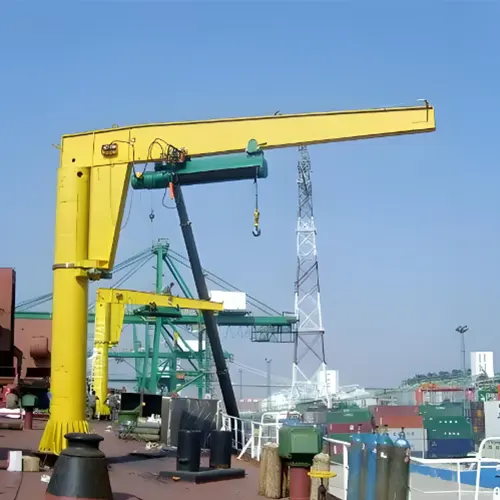
11 Tons to 16 Tons
Applications:
- Heavy Industry and Manufacturing: Suitable for lifting large machinery components, heavy parts, and bulky materials in industrial environments.
- Large Warehouses and Distribution Centers: Efficient for handling large volumes of heavy goods and equipment.
Features:
- High Stability: Provides excellent stability and strength for lifting very heavy loads, often equipped with enhanced safety features.
- Advanced Control Systems: Typically comes with advanced load monitoring and control systems to handle heavy lifting tasks safely.
Considerations:
- Structural Requirements: Requires a strong and stable floor foundation to support the high loads and operational stresses.
- Cost and Maintenance: Higher initial cost and ongoing maintenance considerations due to the complexity and size of the crane.
Factors Affecting Capacity Selection
When choosing a floor-mounted jib crane with a capacity ranging from 1 ton to 16 tons, consider the following factors:
- Maximum Load Weight: Determine the maximum weight of the loads you need to lift to ensure the crane's capacity meets or exceeds this requirement.
- Load Distribution: Understand how the load is distributed across the jib arm to ensure stability and prevent overloading.
- Operational Frequency: Consider how often the crane will be used and the load frequency to choose a crane that can handle your operational demands effectively.
- Environmental Conditions: Assess the environment in which the crane will be operating, including factors such as exposure to moisture, dust, or extreme temperatures, to select a crane with appropriate materials and protective features.
By understanding these details, you can select the appropriate floor-mounted jib crane that meets your specific capacity requirements and operational needs.
Wall-Mounted vs. Floor-Mounted Jib Cranes

Attachment and Installation
Wall-mounted jib cranes are anchored to a wall or a building structure, which supports the crane's load-bearing capacity. This design is ideal for facilities where floor space is limited but wall space is available. The installation process involves securing the crane's mounting bracket to the wall, ensuring it is properly aligned and supported to handle the intended loads.
Advantages
- Space Efficiency: By utilizing existing wall structures, wall-mounted cranes free up valuable floor space, making them suitable for confined or crowded environments.
- Cost-Effective: Wall-mounted cranes generally require less structural modification compared to floor-mounted models, which can result in lower installation costs.
- Ideal for Smaller Loads: They are often used for lighter loads and tasks requiring less reach, making them suitable for tasks like handling smaller components or tools.
Limitations
- Limited Reach: The reach of wall-mounted cranes is constrained by the wall's position and height, which may limit their application for certain tasks.
- Wall Dependency: The strength and stability of the wall must be sufficient to support the crane and its loads. Inadequate wall support can compromise safety and performance.
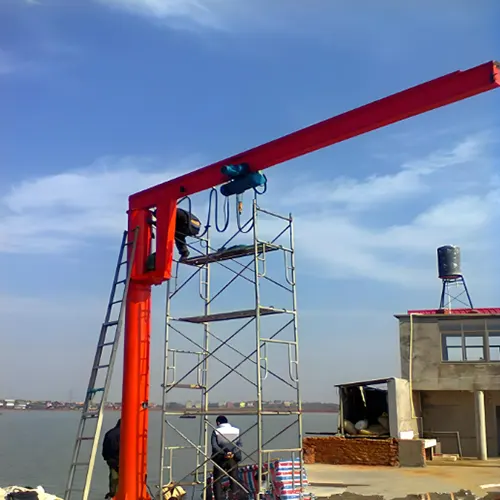
Floor-Mounted Jib Cranes for waterside Use
Attachment and Installation
Floor-mounted jib cranes are anchored directly to the floor, providing a stable and robust foundation for the crane's operations. This design allows for a wide range of motion and is typically used in open areas where floor space is available. The installation involves bolting the crane's base to the floor and ensuring it is securely aligned to handle heavy loads effectively.
Advantages
- Greater Stability: The direct attachment to the floor provides excellent stability and supports heavier loads compared to wall-mounted models.
- Flexible Reach: Floor-mounted cranes offer more flexibility in reach and operation since they are not limited by wall constraints. They can cover a larger area and handle a broader range of tasks.
- Enhanced Mobility: Floor-mounted models can be repositioned more easily than wall-mounted cranes if the facility's layout changes or if different tasks require different crane locations.
Limitations
- Space Requirement: These cranes require adequate floor space for installation and operation. They may not be suitable for facilities with limited floor area.
- Higher Installation Costs: The need for a robust floor foundation and potential modifications can increase installation costs compared to wall-mounted options.
Choosing Between Wall-Mounted and Floor-Mounted Jib Cranes
The choice between wall-mounted and floor-mounted jib cranes depends on several factors:
- Available Space: If floor space is limited and wall structures are strong enough, a wall-mounted crane may be more suitable. In open areas with ample floor space, a floor-mounted crane offers greater flexibility.
- Load Requirements: For heavier loads and tasks requiring extensive reach, floor-mounted cranes are generally preferable. Wall-mounted cranes are typically used for lighter loads and confined spaces.
- Operational Needs: Consider the need for mobility and the potential for future changes in facility layout. Floor-mounted cranes provide more adaptability, while wall-mounted cranes are fixed in place.
By evaluating these factors, you can select the type of jib crane that best fits your facility's layout, operational requirements, and load-handling needs.
Applications and Benefits
Manufacturing and Assembly Lines
Floor-mounted jib cranes play a critical role in manufacturing and assembly lines by enhancing the handling and movement of components and materials. Here's a closer look at their impact in these environments:
- Efficient Movement of Heavy Components: These cranes are designed to handle substantial loads with ease, enabling the smooth transfer of heavy parts between different stages of production. This capability helps reduce the need for manual lifting, which can be labor-intensive and time-consuming.
- Improved Assembly Efficiency: By positioning parts precisely and accurately, floor-mounted jib cranes facilitate efficient assembly processes. This precision is crucial for maintaining high production quality and minimizing errors, as components can be positioned exactly where needed without the risk of misalignment.
- Reduced Manual Handling: The use of jib cranes minimizes the physical strain on workers, reducing the risk of injuries related to manual lifting and carrying. This contributes to a safer workplace and allows employees to focus on more complex tasks.
Warehousing and Distribution
In warehousing and distribution centers, floor-mounted jib cranes are indispensable for their versatility and efficiency in managing inventory and goods. Their applications include:
- Loading and Unloading: Jib cranes streamline the process of loading and unloading products from shelves or pallets. They handle bulky items and heavy loads, making it easier to move goods into and out of storage areas.
- Handling and Repositioning: These cranes are used to reposition inventory within the warehouse, optimizing storage space and ensuring that items are accessible when needed. This flexibility improves overall warehouse organization and efficiency.
- Enhanced Inventory Management: By facilitating quicker and more efficient movement of goods, floor-mounted jib cranes contribute to faster order fulfillment and improved inventory management. They enable warehouses to keep pace with high-volume operations and rapidly changing stock levels.
Maintenance and Repair Facilities
Floor-mounted jib cranes are essential in maintenance and repair facilities, offering significant benefits for servicing and repairing heavy equipment:
- Easy Access to Equipment: These cranes provide the necessary lift and maneuverability to access and position large machinery parts or tools. This capability simplifies the process of servicing or repairing equipment, making maintenance tasks more manageable.
- Reduced Physical Strain: By handling heavy components, jib cranes reduce the physical demands on technicians, lowering the risk of musculoskeletal injuries and improving overall workplace safety. Technicians can perform their tasks with less physical effort and greater precision.
- Frequent Maintenance Needs: In environments where equipment undergoes frequent maintenance or repair, jib cranes offer a reliable solution for managing heavy parts and tools. Their durability and ease of use make them a valuable asset in maintaining operational efficiency and minimizing downtime.
In summary, floor-mounted jib cranes are versatile tools that significantly enhance productivity and safety across various industrial applications. Whether in manufacturing, warehousing, or maintenance settings, their ability to handle heavy loads and streamline processes makes them a crucial component in efficient operations.
Benefits of Floor Mounted Jib Cranes
Flexibility and Maneuverability
Floor-mounted jib cranes offer remarkable flexibility and maneuverability, which are crucial for various industrial applications:
- Wide Range of Motion: The horizontal movement of the jib arm allows for extensive reach and the ability to handle loads from multiple angles. This flexibility is particularly beneficial in environments where materials need to be moved to different positions or angles within a confined space.
- Precision Placement: The ability to control the jib arm's movement with precision enables accurate placement of loads. This is essential in settings where precise alignment is necessary for assembly, loading, or other tasks, reducing the likelihood of errors and improving overall operational efficiency.
- Adaptability in Dynamic Environments: The adaptability of floor-mounted jib cranes makes them suitable for dynamic work environments where tasks and load positions frequently change. Their maneuverability ensures that they can handle varying load requirements and adjust to different operational needs efficiently.
Space Efficiency
Floor-mounted jib cranes are designed to optimize the use of available space in industrial facilities:
- Compact Design: These cranes are typically compact and do not require extensive overhead structures, which helps in utilizing floor space more effectively. Their design allows them to operate efficiently in areas with limited space, making them ideal for smaller workshops or warehouses.
- Efficient Use of Workspace: By eliminating the need for large overhead systems, floor-mounted jib cranes maintain a clear working area. This contributes to a more organized and less cluttered workspace, enhancing safety and ease of movement for workers.
- Confined Area Operation: Their ability to operate in confined areas without compromising on performance allows businesses to maximize their workspace and improve overall facility layout. This efficiency is crucial for facilities that need to make the most of their available space.
Improved Workflow and Productivity
Integrating floor-mounted jib cranes into industrial operations can lead to significant improvements in workflow and productivity:
- Streamlined Material Handling: Floor-mounted jib cranes simplify and accelerate the process of lifting and moving materials. This reduces the time and effort required for manual handling and speeds up overall operations.
- Reduction in Manual Labor: By handling heavy and bulky loads, these cranes reduce the reliance on manual labor, which can be physically demanding and time-consuming. This not only decreases worker fatigue but also minimizes the risk of injuries associated with manual lifting.
- Enhanced Operational Efficiency: The improved speed and efficiency in material handling lead to smoother workflows and faster turnaround times. As a result, facilities can handle more tasks within a given period, increasing their overall productivity and output.
In summary, floor-mounted jib cranes provide significant benefits in terms of flexibility, space efficiency, and productivity. Their ability to maneuver loads precisely, optimize workspace, and streamline operations makes them a valuable asset in a wide range of industrial applications.
Capacity and Load Considerations
Capacity Range Overview
General Range of Capacities (1 Ton to 16 Tons)
Floor-mounted jib cranes are available in a range of capacities to meet various lifting needs, typically from 1 ton to 16 tons. This range allows these cranes to handle a wide variety of loads, from small, heavy components to larger, bulkier items. The selection of capacity depends on the specific requirements of the application and the type of loads being lifted.
- 1 Ton to 5 Tons: Ideal for smaller, lighter loads and applications requiring precise positioning within tight spaces. Suitable for light manufacturing, small workshops, and inventory handling.
- 6 Tons to 10 Tons: Suitable for moderate to heavy loads. Commonly used in medium-sized manufacturing facilities, warehouses, and maintenance areas.
- 11 Tons to 16 Tons: Designed for heavy-duty applications, including large machinery and bulky materials. Often used in heavy manufacturing, large distribution centers, and industrial maintenance operations.
Factors Affecting Capacity Selection
Choosing the appropriate crane capacity involves considering several factors:
- Load Weight: The maximum weight of the items to be lifted determines the required crane capacity. It is crucial to select a crane with a capacity that exceeds the heaviest load to ensure safe and efficient operation.
- Load Distribution: The way the load is distributed across the jib arm can affect crane performance. Uneven loads may require a crane with a higher capacity to ensure stability and safety.
- Working Environment: The operating conditions, such as space constraints and environmental factors, can influence the required capacity. For instance, cranes used in confined spaces may need to handle loads with more precision.
- Frequency of Use: Frequent lifting of heavy loads may necessitate a crane with a higher capacity to ensure long-term durability and reduce wear and tear.
Load Handling and Ergonomics
Types of Loads Handled
Floor-mounted jib cranes are designed to handle a variety of loads, including:
- Bulky Items: Large or cumbersome objects that are difficult to move manually. The crane's reach and lifting capabilities make it easier to maneuver such items within the workspace.
- Machinery Parts: Heavy or awkwardly shaped components that require precise handling during assembly, maintenance, or repairs. The crane's flexibility and control allow for accurate placement and repositioning.
Ergonomic Considerations for Operators
Ergonomics plays a vital role in ensuring the safety and efficiency of crane operations:
- Ease of Operation: The design of the crane should facilitate easy control of the hoist and jib arm, minimizing physical strain on the operator. Ergonomically placed controls and smooth movements contribute to comfortable operation.
- Safe Load Handling: Proper crane design helps prevent excessive lifting efforts and reduces the risk of injury. Features such as adjustable height and reach options enhance the operator's ability to handle loads safely.
- Visibility and Access: Ensuring clear visibility of the load and working area helps operators make precise adjustments and avoid collisions. Design elements like rotating jibs and adjustable positions contribute to better access and safety.
By considering these capacity and load handling factors, you can select a floor-mounted jib crane that meets your operational needs while ensuring safety and efficiency.
Buying Guide for Floor-Mounted Jib Cranes (1 Ton to 16 Ton)
Key Factors to Consider
Load Capacity and Requirements
When selecting a floor-mounted jib crane, the load capacity is a crucial factor. Determine the maximum weight of the loads you will be handling and choose a crane with a capacity that exceeds this weight. This ensures safe and efficient lifting operations. Consider not just the maximum load, but also the typical loads and how they are distributed across the jib arm, as this can affect the crane's performance and stability.
Height and Reach Specifications
The height and reach of the jib crane must match the requirements of your workspace. Measure the distance from the floor to the highest point you need to reach, and ensure the crane's vertical lift and horizontal reach accommodate this. The jib arm's length should be sufficient to cover the required operating radius without compromising safety or maneuverability.
Space and Layout Considerations
Evaluate the available space where the crane will be installed. Floor-mounted jib cranes require adequate clearance around the base and jib arm to operate effectively. Consider the layout of your facility to ensure the crane can be positioned optimally for efficient load handling and minimal interference with other equipment or workflows.
Material and Design Considerations
Material Options (Steel, Aluminum)
- Steel: Steel is a common choice for its strength and durability. It can support heavy loads and withstand harsh working conditions. Steel cranes are typically more robust and are suitable for heavy-duty applications.
- Aluminum: Aluminum is lighter than steel, making it easier to maneuver and install. It is resistant to corrosion, which makes it ideal for environments where rust is a concern. However, it may not be suitable for extremely heavy loads compared to steel.
Design Features for Durability and Performance
Choose a crane with design features that enhance its durability and performance. Look for high-quality bearings and joints that reduce wear and tear. Consider features such as corrosion-resistant coatings, reinforced structures, and high-strength components to ensure the crane can withstand the demands of your operation.
Safety Features
- Anti-Collision Systems:Anti-collision systems help prevent accidents by alerting operators to potential collisions with other equipment or structures. Look for cranes equipped with sensors or warning systems that provide real-time feedback and enhance safety during operation.
- Load Monitoring and Control Systems:Advanced load monitoring systems track the weight and distribution of loads, ensuring that the crane operates within safe limits. Control systems should provide precise operation and adjustments, helping to maintain stability and prevent overloading.
- Maintenance and Inspection Requirements:Regular maintenance and inspections are essential to ensure the crane's longevity and safe operation. Choose a crane that allows for easy access to components for maintenance and follow recommended inspection schedules to identify and address potential issues promptly.
Customization Options
- Custom Jib Lengths and Angles:Depending on your specific needs, you may require customized jib lengths or angles. Customization allows the crane to fit your workspace more effectively and handle loads more efficiently. Work with suppliers who offer tailored solutions to meet your precise requirements.
- Special Features for Hazardous Environments:For operations in hazardous environments, consider cranes with special features such as explosion-proof components, enhanced anti-corrosion treatments, or safety enclosures. These features ensure the crane remains functional and safe under challenging conditions
Cost and Budgeting
Price Ranges for Different Capacities
The cost of floor-mounted jib cranes varies based on their capacity. Generally, cranes with higher capacities will be more expensive. Understand the price ranges for different capacities to align your budget with your needs.
Price Ranges for Different Capacities (0.5 Ton to 16 Ton) in China
In China, the cost of floor-mounted jib cranes is generally lower due to local manufacturing and competitive pricing. Here's an overview of typical price ranges:
- 0.5 Ton Jib Cranes: Prices typically range from $800 to $1,500, offering a cost-effective solution for small-scale material handling tasks.
- 1 Ton Jib Cranes: These cranes usually cost between $1,200 and $2,500, providing an affordable option with a higher load capacity.
- 2 Ton Jib Cranes: You can expect to pay $2,000 to $4,000 for these cranes, which are suitable for more demanding applications in small to medium workshops.
- 5 Ton Jib Cranes: Prices range from $4,000 to $8,000, reflecting the increased capacity and additional structural features needed for larger operations.
- 10 to 16 Ton Jib Cranes: High-capacity cranes in this range are generally priced between $8,000 and $20,000, depending on customization, materials, and any advanced features included.
These price ranges in China provide a more affordable option for companies looking to invest in floor-mounted jib cranes, allowing businesses to meet their material handling needs without exceeding budget constraints.
Cost Factors and Potential Additional Expenses
When purchasing a floor-mounted jib crane, the initial price is just one part of the total cost. It's essential to consider additional expenses to ensure a comprehensive budget:
- Installation Costs: Installation is a critical factor that can add to the overall expense. Depending on the complexity of the setup and the crane's capacity, professional installation services may be required. This can range from a few hundred to several thousand dollars, especially if specialized equipment or labor is needed.
- Customization: If your application requires specific modifications, such as a longer boom, increased rotation angle, or additional safety features, customization costs can significantly impact the price. Custom-built jib cranes can be tailored to your needs but often come with a premium price tag.
- Maintenance: Routine maintenance is essential to keep the crane in optimal working condition. This includes regular inspections, lubrication, and potential part replacements. While maintenance costs are generally lower for smaller capacity cranes, they can add up over time, particularly for higher capacity models that may require more frequent or specialized upkeep.
- Accessories and Upgrades: Depending on your specific operational requirements, you may need additional accessories such as specialized hoists, control systems, or safety devices. These extras can increase the overall cost but are often necessary to maximize the crane's functionality and safety.
- Training: Operator training may be required to ensure safe and efficient use of the crane. While some basic training might be included with the purchase, advanced or specialized training sessions could incur additional costs.
By thoroughly evaluating these factors, you can develop a well-rounded budget that accounts for not only the purchase price but also the ongoing expenses associated with owning and operating a floor-mounted jib crane. This comprehensive approach ensures you select a crane that meets your operational needs without unexpected financial surprises.
Where to Buy Floor-Mounted Jib Cranes
Online and Offline Purchasing Options
You can purchase floor-mounted jib cranes through several channels:
- Online Suppliers: Websites like Amazon Business, Alibaba, and industrial equipment marketplaces offer a wide range of jib cranes. Online purchasing provides convenience and the ability to compare different models and suppliers easily.
- Manufacturer Websites: Purchasing directly from the manufacturer's website allows you to access the latest models, detailed specifications, and customization options. It also often includes direct support and warranty services.
- Local Distributors and Dealers: Local industrial equipment dealers and distributors offer the advantage of personalized service and the opportunity to view the equipment in person. They can provide expert advice and assist with installation and support.
Comparing Quotes and Services
Requesting Detailed Quotations
When obtaining quotes for floor-mounted jib cranes, ensure you request detailed quotations from multiple suppliers. A comprehensive quote should include:
- Equipment Cost: The base price of the crane, including any standard features.
- Customization Costs: Additional charges for custom features or modifications.
- Installation Fees: Costs associated with the delivery and installation of the crane.
- Warranty and Support: Details on warranty coverage and any associated costs.
Comparing quotes helps you understand the full cost of ownership and make an informed decision based on your budget and requirements.
Evaluating Service and Support Options
Assess the service and support options offered by each supplier. Consider the following factors:
- Customer Service: The responsiveness and helpfulness of the supplier's customer service team. Good customer service ensures you receive prompt assistance with inquiries and issues.
- Technical Support: Availability of technical support for installation, troubleshooting, and maintenance. Ensure that the supplier offers reliable support to address any technical challenges.
- Maintenance Services: Availability of maintenance and repair services, including routine checks and emergency support. A supplier with strong maintenance services can help prolong the lifespan of your crane and ensure ongoing performance.
By carefully evaluating these aspects, you can select a reputable supplier and obtain a floor-mounted jib crane that meets your operational needs and provides reliable long-term support.
FAQs on Floor Mounted Jib Cranes to Solves Your Concerns
Here are the answers and solutions to the related questions in the format of FAQs:
Purchase and Selection
Q: What lifting capacity do I need for my specific tasks?
A: Determine the heaviest load you'll regularly handle and choose a crane with a capacity slightly higher than that to account for variations.Q: What is the suitable jib arm length and rotation angle for my workspace?
A: Measure your workspace to determine the required boom length and rotation angle that provide optimal coverage without obstruction.Q: How do I choose between different types of hoists and trolleys?
A: Consider factors like load type, speed, and precision. Electric chain hoists are versatile, while wire rope hoists handle heavier loads.Q: What safety features should be included in the crane?
A: Safety features may include limit switches, emergency stop buttons, overload protection, and warning indicators to enhance operator safety.Installation
Q: What are the foundation requirements for a floor-mounted jib crane?
A: Foundation specifications depend on crane size and load capacity. Consult the manufacturer's guidelines for proper foundation design.Q: Can the crane be installed indoors and outdoors?
A: Yes, floor-mounted jib cranes can be installed in both indoor and outdoor environments, provided the crane is designed for outdoor use.Q: How do I ensure proper alignment and stability during installation?
A: Follow the manufacturer's installation manual meticulously to ensure accurate alignment and use leveling shims if necessary.Q: Do I need to reinforce the floor for installation?
A: Depending on the load capacity and your floor's condition, reinforcing the foundation may be required. Consult an engineer if in doubt.Safety and Regulations
Q: What safety measures are essential for crane operation?
A: Key safety measures include operator training, implementing safety devices, clear load capacity labels, and adhering to operational guidelines.Q: Do floor-mounted jib cranes comply with relevant safety standards and regulations?
A: Reputable manufacturers design cranes to meet or exceed safety standards such as OSHA, CMAA, or regional regulations.Q: What precautions should I take to prevent accidents and ensure operator safety?
A: Train operators thoroughly, establish safety protocols, regularly inspect the crane, and provide proper personal protective equipment (PPE).Operational Considerations
Q: How can I optimize the crane's performance and efficiency for my specific tasks?
A: Choose the right hoist and trolley options, adhere to load capacity limits, and conduct regular maintenance to ensure optimal performance.Q: What are the load capacity limitations at different boom angles?
A: Consult the crane's load chart provided by the manufacturer to determine safe load capacities at various boom angles.Q: How do I control the crane and ensure smooth movements?
A: The crane can be controlled using pendant controls or remote controls, ensuring precise and smooth movements.Q: Can the crane be operated in tight spaces or near obstacles?
A: Yes, the crane's rotation and compact design allow it to operate effectively in confined spaces while avoiding obstacles.Maintenance and Longevity
Q: What is the recommended maintenance schedule for a floor-mounted jib crane?
A: Follow the manufacturer's maintenance recommendations, including regular inspections, lubrication, and addressing wear and tear promptly.Q: How do I inspect the crane for wear and tear?
A: Perform visual inspections for signs of rust, corrosion, loose parts, and abnormal sounds during operation. Address any issues promptly.Q: Are there any specific lubrication requirements for smooth operation?
A: Follow the manufacturer's guidelines for lubrication points and intervals to ensure smooth and efficient crane movement.Q: How can I extend the crane's lifespan and minimize downtime due to maintenance?
A: Regular maintenance, operator training, adhering to load capacities, and prompt repair of minor issues can extend the crane's lifespan.Remember, addressing these FAQs and concerns ensures that you make informed decisions, maximize safety, and optimize the performance of your floor-mounted jib crane. Always rely on manufacturer guidelines and industry best practices for best results.
Conclusion: Customized Floor Mounted Jib Cranes for Your Needs
In summary, floor-mounted jib cranes are essential for enhancing productivity and efficiency in various industrial settings. They offer a versatile lifting solution with a range of capacities from 1 ton to 16 tons, making them suitable for diverse applications such as manufacturing, warehousing, and maintenance. Understanding the key components, types, and benefits of these cranes helps in making an informed choice.
When selecting a floor-mounted jib crane, it is crucial to consider factors such as load capacity, height and reach specifications, and space constraints. Material options and design features impact the crane's durability and performance, while safety features and customization options ensure the crane meets specific operational needs. Additionally, comparing quotes and evaluating service options from reputable suppliers can help you find the best value for your investment.
Final Tips for Selecting the Right Floor-Mounted Jib Crane
- Assess Your Needs: Clearly define your lifting requirements, including load weights, reach, and workspace constraints. This will guide you in selecting a crane that matches your operational demands.
- Evaluate Material and Design: Choose a crane made from high-quality materials and with a design that suits your environment and load handling needs. Consider durability and performance features to ensure long-term reliability.
- Prioritize Safety: Ensure the crane includes essential safety features such as anti-collision systems and load monitoring. Proper maintenance and regular inspections are also crucial for safe operation.
- Explore Customization: If your application has unique requirements, explore customization options to tailor the crane to your specific needs. Custom jib lengths, angles, and features for hazardous environments can enhance the crane's effectiveness.
- Budget Wisely: Factor in the total cost of ownership, including purchase price, installation, customization, and maintenance. Ensure the crane fits within your budget while meeting your operational requirements.
Selecting the right floor-mounted jib crane can be complex, and consulting with industry experts can provide valuable insights and tailored solutions. Experts can help you navigate through various options, ensure that your chosen crane meets all your specific needs, and provide guidance on installation and maintenance. Engaging with professionals ensures that you make a well-informed decision and invest in a crane that will enhance your facility's efficiency and safety.
Main Projects
Related Products

Latest project
32/5 Ton Overhead Crane Sale in India: Case Study
Free consultation to Confirm Parameters & Specifications and Get
Latest Crane Price & Crane Rate.
- Types of overhead cranes : _______?
- Optional: Overhead travelling crane, goliath gantry crane,Slewing jib crane, Single girder or double girder crane,small portable crane or kbk crane, etc.
- Capacity of overhead crane: _______?
- Optional: 0.25ton, 0.5 ton, 1 ton, 2 ton, 3ton, 5 ton, 10 ton,15ton, 20ton, 25 ton, 30ton,35ton, up to 550ton, etc.
- Crane span & lifting height : _______?
- Crane travelling length : _____?
- Control of overhead crane:_______?
- Optional: pendant/ remote/cabin control
- Voltage supply of overhead crane:_____?
- Eg,: 380V50/60HZ,3Phase or others,etc.
- Application/usage of crane:_______?
- Eg,: Steel mill, ,injection mold, cement,stone, concrete,granite, general manufacturing, etc.
Just leave a message via the contact form and our hoist and crane engineer will contact you with in 24working hours.
Get In Touch
